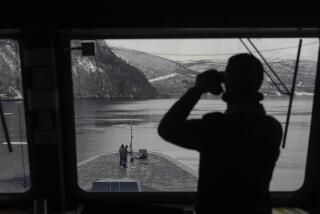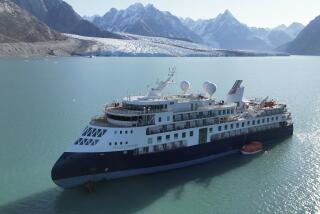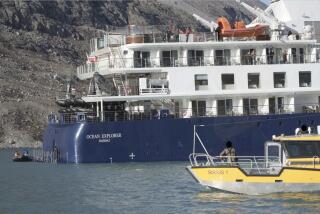Tass Says Sub Had Nuclear Arms, 42 Died
- Share via
OSLO — Forty-two sailors were killed when their nuclear-powered Soviet attack submarine sank Friday in Arctic waters north of the Norwegian coast and 27 others were rescued, the Soviet news agency Tass reported Sunday. The agency also disclosed that the sub was carrying two nuclear-tipped torpedoes.
But Tass said the weapons posed no threat to the environment. “The design of the warheads completely rules out radiation threat during large-depth submergence,” the agency said.
The vessel’s nuclear reactors were shut down before the submarine sank, Tass said, reiterating messages to world leaders Saturday from President Mikhail S. Gorbachev that were designed to allay fears over the danger of possible radioactive contamination. It said there was no danger of such contamination, even under the intense water pressure on the seabed more than 4,500 feet below the surface, where the submarine came to rest.
“To ensure radiation safety, the nuclear-powered engine was stopped, and the power unit was effectively blanked off. The possibility of the destruction of the hull is ruled out,” the official news agency said.
Initial monitoring of radiation levels in water and air samples taken around the scene have shown them to be normal, Tass said. Preliminary tests on air samples taken from the scene by a Norwegian patrol plane showed no abnormal levels of radiation.
Tass said Soviet vessels will remain at the scene to continue the monitoring effort.
Reporting from the headquarters of the Soviet Northern Fleet at Murmansk, Tass said that the submarine was carrying a crew of 69, only a third of whom were rescued. It said the crew “displayed courage in the struggle to keep (the submarine) afloat” in their long and losing five-hour battle against a fire that broke out in the stern of the submarine on Friday.
The boat’s complement of 69 as reported by Tass is considerably lower than the North Atlantic Treaty Organization assessment that the “Mike” class submarine--reportedly the only one of its kind--carries a crew of about 95.
Also, Tass spoke of one reactor, whereas the Pentagon’s study, “Soviet Military Power,” says there are two.
The Soviet armed forces newspaper Red Star reported Sunday that the submarine’s commander, identified only as Capt. Ye. Vanin, was returning to port from a long voyage. The newspaper did not disclose the skipper’s fate.
While the submarine was submerged, there was an Arctic storm on the sea above. A fire broke out in the submarine’s seventh compartment, believed to be its engine room, according to Tass, and spread immediately to the adjacent compartment, where more machinery and equipment would be housed.
Cause of Fire Unknown
An explosion reportedly followed. The cause of the fire is not yet known, though Western naval officers here suggest that an electrical short or possibly a buildup of bilge gas are the most likely causes.
While the crew managed to bring the submarine to the surface quickly, Red Star said, they were unable to put out the fire. “The crew fought the fire for more than five hours, trying to save the submarine, but to no avail,” Red Star said. It added that a “decision was made” to abandon the vessel, and it sank.
There was no indication of how many of the crew perished in the fire aboard the submarine or died in the frigid waters after leaving it.
“All of the rescue means of the fleet were immediately deployed,” Red Star continued. Military aircraft dropped life rafts, warships and other naval vessels steamed to the area and civilian ships, among them fishing trawlers and fish-processing ships, also came. Those rescued were put aboard the Soviet cruiser Kirov, which brought them to Murmansk on Sunday afternoon.
A Norwegian P-3 Orion patrol aircraft, the only Western witness at the sinking site, arrived shortly after the submarine went down.
The fliers aboard saw survivors clinging to a life raft in the gray waters.
‘No Movement on Raft’
“There was no movement on the raft,” crewman Lasse Laurizen told NTB, the Norwegian news agency. “But it was so packed that it would hardly have been possible to move.
“It was impossible to count them because of the speed we had to maintain,” said the airman, “or to tell what condition they were in. There were two lifeless figures in the water about 100 meters from the raft.
“We also saw another raft bobbing up and down, empty. There was a patch of oil. It was the only trace of the submarine.”
The stricken vessel, according to Norwegian officials, sent out a distress signal after it originally surfaced--but on a Soviet naval frequency and not on the international SOS channel monitored by rescue services.
Informed sources here said that the Soviet emergency network was probably monitored by U.S. or Norwegian intelligence agencies that therefore diverted the P-3 Orion, which was on a routine patrol, to the scene of the sinking.
Soviet Notification Delay
Defense Minister Johan Joergen Holst reported Sunday that had Norway been officially notified by the Soviets, rescue helicopters or ships could have reached the scene long before the Soviet vessels.
“It took longer for the Soviets to inform us than we would have wished,” Holst said, “and then only after we had asked for information.”
But the defense minister added that the Soviets were not obligated to inform anyone since the submarine was in international waters.
Despite repeated Soviet assurances that there was no danger of radiation contamination, the Norwegian government was taking no chances. It continued to test air and water samples from the area.
“These tests checked to see if the Soviet submarine released radiation at or near the surface,” said Per Strand, a researcher with the Norwegian Institute for Radiation Protection here, “but cannot exclude the possibility of such a leak deeper in the ocean.”
Research Vessel Dispatched
Therefore, the Norwegian government said, it was sending a research vessel from the northern port of Hammerfest to the site of the sinking--about 120 miles southwest of Norway’s Bear Island in the Norwegian Sea--to take deeper samples all the way to the bottom.
These new, deep samples were not expected to be analyzed before Tuesday, government sources said.
On Saturday, Soviet President Mikhail S. Gorbachev informed Norwegian Prime Minister Gro Harlem Brundtland--as well as President Bush and British Prime Minister Margaret Thatcher--that there was no chance of radioactive contamination.
Gorbachev’s words were designed to allay Western fears that radioactivity might be released--as was the case with the Chernobyl nuclear power plant accident in the Ukraine three years ago.
The submarine was an experimental model--361 feet long, 9,700 tons submerged, commissioned in 1984--that naval analysts say had a titanium hull, liquid-metal cooled reactors and a propulsion system that allowed it to dive deeply and run quieter and faster than other Soviet subs.
Tuohy reported from Oslo and Parks from Moscow.
COUNTING THE COST Tass said 42 Soviet sailors died when their nuclear-powered attack submarine sank in Arctic waters; 27 were saved.
The stricken vessel carried two nuclear-tipped torpedoes to the bottom with it, Tass said. Initial reports placed the sinking farther north.
More to Read
Sign up for Essential California
The most important California stories and recommendations in your inbox every morning.
You may occasionally receive promotional content from the Los Angeles Times.










